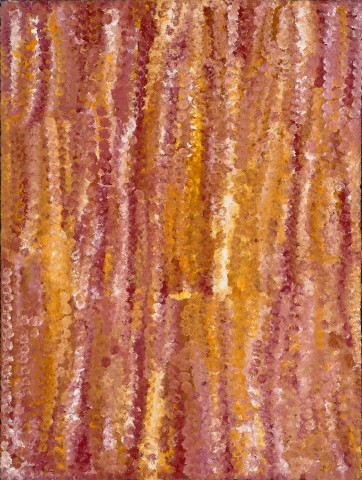LIFE CYCLE III, 1994
EMILY KAM KNGWARREYE
synthetic polymer paint on linen
121.0 x 91.5 cm
signed verso: Emlly [sic]
bears inscription verso: artist’s name and Delmore Gallery cat. 94G016
Commissioned by Delmore Gallery, via Alice Springs, Northern Territory in 1994
The Thomas Vroom Collection, The Netherlands
Leonard Joel, Melbourne, 26 February 2017, lot 85
Private collection, Sydney
on long term loan to the Aboriginal Art Museum, Utrecht, The Netherlands
Emily Kngwarreye: Paintings and Prints from the Thomas Vroom Collection, Olsen Irwin Gallery, Sydney, 6 – 24 July 2016, cat. 11 (illus. in exhibition catalogue)
This work is accompanied by a certificate of authenticity from Delmore Gallery.
Undoubtedly one of Australia’s greatest painters of the twentieth century, Emily Kam Kngwarreye’s success came after a lifetime making art – initially in her role of ceremonial leader, painting the bodies of fellow Anmatjerre women for ceremony, subsequently as a prominent member of the Utopia Women’s Batik Group and finally, in the later years of her life, sustaining the unprecedented demand for her paintings following the successes of her early exhibitions.
Often a response to the everchanging landscape of her traditional homelands at Alhalker (Alalgura) close to Utopia, north east of Alice Springs, the paintings of country by Emily Kngwarreye record her acute observation, often in minute detail, of the shifting fluctuations in the state of the flora around her, alerting her to the readiness of bush food or medicinal plants. Painted in 1994, Life cycle III celebrates the post-summer dryness, where a muted carpet of scattered seeds and grasses dot the landscape yet despite the dryness, underground tuber vegetables and certain berries are ripe for picking. Judith Ryan notes that, ‘clearly Emily Kngwarreye was a mark-maker extraordinaire…. she ventured further with masses of dots and marks, making intimate and grand gestures layering and intensifying the dots to the exclusion of graphic elements.’1Here the layers of white, yellow, purple, and burnt sienna dots, in many places applied by the artist using her fingers, faithfully evoke the colours of her country, while the ground may be seen as the spread of the roots of Emily Kam Kngwarrere’s totemic yam plant underground, and the spread of ancestral forces through the earth.
The accompanying certificate notes, ‘On this canvas, the artist's choice of yellow represents the most important plant in her custodianship, namely the ‘Anooralya’, a hardy and fertile plant that provides both a tuber vegetable and a seed-bearing flower called ‘kame’ – Emily's tribal name. Other colours reflect the time of the season when particular bush flowers flourish. These flowers contain seeds that are collected to make types of seed cake, damper, medicines and love potions. The presence of purple symbolises the ‘nterkwe’, or bush plum, when plump and ripe enough to eat. The dots being placed in lines connect with the practice of anointing the body with lineal designs during ceremony, thus adding another dimension of celebration in the execution of this painting.
Ceremony reinforces through narrative, the significance of this knowledge. As well, it teaches basic social codes and obligations. Through her paintings, she serves to reinforce her knowledge amongst those who are to carry on after her.’2
Following in the wake of the success of Western Desert painting, Emily Kngwarreye became nationally and internationally recognised for the way in which her painting intuitively responded to her specific cultural experience. The many stylistic shifts she effortlessly adopted allowed her work to evolve yet be constantly fresh.
1. Ryan, J. cited in Isaacs, J. et al., Emily Kngwarreye Paintings, Craftsman House, Sydney, 1998, p. 77
2. Taken from the accompanying certificate of authenticity from Delmore Gallery.
CRISPIN GUTTERIDGE

